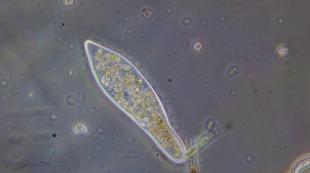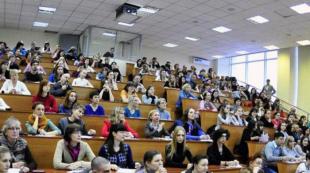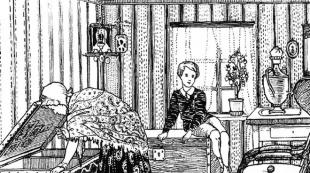Life processes of infusoria. Reproduction of infusoria-shoes. Respiration and excretion of infusoria shoes
The infusoria shoe has been known since school biology lessons. This is one of the types of ciliated unicellular organisms that does not belong to the animal, plant or fungal kingdom, but is included in the intermediate group of protists. The creature lives in fresh water, and it received an interesting name for the constant shape of the body, similar to the imprint of the sole of a shoe.
Infusoria slipper - ciliary unicellular organism, which is included in the intermediate group of protists
scientific classification
The type of ciliates belongs to the super-kingdom of eukaryotes, that is, organisms with a nucleus. They correspond to the ciliary type, the class Oligohymenophorea and the genus Paramecium. A feature of representatives of this rank is the preference for acidic environmental conditions.
Researchers at one time spent a lot of effort on deciphering the genome of some species related to paramecia. It turned out that it contains 40,000 protein-coding genes, while humans have only about 28,000 of them. The increase in the number of genes occurred as a result of several duplications of the original genome. The method of coding the sequence of amino acid residues in ciliates is unique in the presence of a single, and not triple, as in the universal genetic code, codon that completes the synthesis of the polypeptide chain.
general description
The optimal habitat for the organism is fresh standing water containing decomposing organic compounds. In particular, these conditions are met by a home aquarium, in the sample of silty water of which protozoa are often found.

The habitat of the infusorian shoe is stagnant water
It is possible to consider ciliates only under a microscope, since its size does not exceed 0.1-0.3 mm. Almost 7% of the cell consists of dry matter, the chemical composition of which is represented by the following components:
- protein (58%);
- lipids (31.4%);
- ash (3.6%).
The body of the ciliates-shoes is covered with a dense layer of cytoplasm, under the outer membrane of which there are such elements of the cytoskeleton as alveoli and microtubules. The body consists of the following elements:
- nucleus (macronucleus);
- nucleolus (micronucleus);
- longitudinal and superficial cilia;
- mouth opening;
- formed and emerging digestive vacuoles (phagosomes);
- an opening through which the digestive vacuole is emptied (cytopig or powder);
- two contractile vacuoles.
Each organelle performs important functions.
Nucleus and nucleolus
The infusoria has two nuclei, each of which has its own structure and functions. Small has a rounded shape, contains hereditary material. Messenger RNAs are poorly read from its genome, so hereditary information is not converted into a protein or other functional product, and there is no gene expression. In the event of the destruction of the nucleolus, the life of the shoe continues, but it will only reproduce asexually, the sexual process will be impossible.
The maturation of a large bean-shaped nucleus leads to complex rearrangements in the hereditary material. All mRNAs are read from its genes, so protein synthesis depends on it. Destroys the nucleus of the sexual process, but at the end of it, the macronucleus is restored again.
Cilia and trichocysts
There are 10 to 15 thousand cilia in a small cell. They grow from basal bodies, which form a complex cytoskeletal system that includes postkinetodesmal fibrils and filaments. At the base of the organelles, parasomal sacs are formed, resulting from the invagination of the outer membrane.
 The ciliates have between 10,000 and 15,000 cilia.
The ciliates have between 10,000 and 15,000 cilia. Between densely spaced infusor cilia there is still room for 5-8 thousand defense organelles called trichocysts. They are one of the varieties of secretory vesicles pushed out by ciliates during exocytosis. They look like bodies with a tip, transversely striated every 7 nm, located in membrane sacs. The protective function is manifested in the instant elongation and firing in case of danger. However, some representatives of ciliates lack such organelles and are quite viable at the same time.
The infusoria-shoe moves with the help of cilia. Making wave-like movements, she swims with a blunt end forward. The organelles make a direct impact in the straightened state. The return is carried out in a curved. This process cannot be called synchronous., since the first eyelash in the row sets the pace, and each subsequent one repeats the action with a slight delay. This leads to the rotation of the shoe around its axis during movement. In a second, it overcomes 2-2.5 mm distances.
By bending the body, the infusoria can change direction. In case of an unexpected collision with an obstacle, it will sharply move back, since the potential difference in its membrane will sharply decrease, and calcium ions will penetrate inside. Then the shoe will move back and forth for some time, during which calcium will leave the cell, and soon continue along the original trajectory.
Nutritional Organs
The mouth of the shoe looks like a depression on the body, turning into a cellular pharynx. Around the mouth opening are complex structures formed from cilia. The infusoria-shoe feeds mainly on algae, bacteria and other small unicellular organisms, which it finds by the chemicals they secrete. Hairy structures around the mouth drive prey down the throat along with the flow of water.
 The mouth of the ciliates looks like a depression on the body
The mouth of the ciliates looks like a depression on the body Next, the food enters the digestive vacuole formed in the process of phagocytosis, and under the influence of the cytoplasmic flow moves to the rear end of the cell, returns to the front, and again goes back. The vacuole merges with lysosomes, which is accompanied by the appearance of an acidic environment, which gradually shifts towards slightly alkaline.
The phagosome migrates and increases the rate of absorption by separating small membrane vesicles. Everything that cannot be digested is thrown out through the powder, devoid of a developed cytoplasm. Digested products are dispersed throughout the intercellular space and are used for life.
After performing its function, the vacuole merges with the outer membrane and collapses, releasing small bubbles. Subsequently, they enter the cell pharynx through microtubules that form the cytoskeleton, where they form a new phagosome.
Interestingly, the abundance of food affects how long the shoe ciliates live. Life expectancy is only a few days with excess nutrition and several months (sometimes up to a year) with a poor diet.
contractile vacuoles
Contractile vacuoles are located on the front and back of the cells. Each of them consists of a reservoir that opens outwards at times, and outgoing radial channels surrounded by many thin tubes that pump fluid from the cytoplasm. The entire fragile system is held by the cytoskeleton.
The main function of these internal organelles is osmoregulation. Diffusion of water molecules into the cell leads to an excess of fluid, which is excreted by vacuoles. The adducting channels pump out water into the reservoir, which then contracts and separates from the tubes, throwing water out of the cell through the pore. Two vacuoles work alternately, each contracting for 10-25 seconds, depending on the ambient temperature. An hour later, the ejected volume of liquid is equal to the volume of the cell itself.
breeding process
The infusoria-shoe reproduces asexually, which consists in transverse division and is accompanied by complex regeneration processes. Since two individuals are obtained from a single individual, each of the new shoes gets one contractile vacuole, and they are forced to complete the missing one on their own. The cellular mouth goes to only one ciliate, and the second at this time has to form a mouth opening with the necessary structures around it. Each representative forms basal bodies and new cilia independently.
Ciliates are also characterized by a sexual process called conjugation, which consists in the transfer of nuclei between partner cells. Shoes formed by the division of different mother cells take part in the process. They are glued together by the oral cavities, resulting in the formation of a cytoplasmic bridge.
 Ciliates can reproduce both asexually and sexually.
Ciliates can reproduce both asexually and sexually. At this time, large nuclei are destroyed in each individual, and small ones are divided, while halving the number of chromosomes. The result is 4 cores, 3 of which are destroyed. The rest divides into two genetically identical nuclei, and each partner develops male and female pronuclei. The female nuclei each remain in their own cell, while the male ciliates are exchanged. During the exchange, the female and male pronuclei merge and a new nucleus is formed, dividing into two more. They become new large and small nuclei.
Learning Opportunities
The story about the infusoria-shoe can be heard at school, but not everyone knows exactly how the researchers studied the tiny organism. In fact, there is nothing difficult in observing it, besides, the size of tenths of a millimeter is quite large for the simplest. All this means that research can be carried out even at home, but first you need to dilute the culture of ciliates.
Since shoes are present in all bodies of water, water is taken from these sources. For the purity of the experiment, you need to take three glass containers and put decaying twigs and leaves in one of them, living plants in the other, and silt from the bottom in the third. All materials are taken from the reservoir, the liquid is also extracted from there and poured into jars.
When everything is ready, you need to carefully examine the contents of the container and make sure that there are no extraneous organisms visible to the eye, such as insects or larvae. If they are, they will have to be caught, otherwise the ciliates will be eaten. The prepared habitat is placed on the window, covered with glass and left at room temperature for several days. In this case, you need to ensure that direct sunlight does not fall on the container.
After two days, the jar should be shaken and checked to see if any organisms have appeared there. It can be both shoes and other creatures, but it is easy to check. You need to take a drop of water from the illuminated wall of the vessel closer to the surface, it is in this place that most of the organisms of interest will concentrate. Then the drop should be placed on glass and examined through a microscope or at least a magnifying glass.
If, at the same time, spindle-shaped bodies are visible, moving quickly and smoothly and rotating around their axis, then it turned out to separate the shoes. If there is a piece of greenery or a bacterial film in the drop, many ciliates will immediately accumulate around the food.
 To speed up the process of reproduction of ciliates, you need to place them in a favorable environment.
To speed up the process of reproduction of ciliates, you need to place them in a favorable environment. It is not difficult to separate the shoe from other animals. Usually they move much faster than other organisms, and this should be used. To do this, a drop, in which there are several types of creatures, is placed on glass and placed in a well-lit place. A small amount of fresh water is poured next to it and a line is drawn with a toothpick from one liquid to another so that a thin water bridge is obtained connecting the two environments. The ciliates will quickly cover the distance and end up in a new drop.
It happens that it is not possible to see anything alive in the water, in which case you can add a few drops of boiled milk to the container and wait another two days. After this time, you can once again try to study the developed organisms.
Further, the shoes will multiply, you can speed up this process by creating favorable conditions for them. To do this, they are placed in one of the following environments:
- on dried banana peel;
- on lettuce leaves;
- into milk;
- in an infusion of hay.
Organisms bred in this way can be used to observe them for research purposes or bring practical benefits. Since ciliates are natural freshwater orderlies, they can disinfect liquid in fish tanks and also serve as food for fry.
Thus, shoe ciliates are amazing organisms with unique features (for example, the sexual process without reproduction), they can be studied even at home.
The most typical widespread representative of ciliary - infusoria slipper(Paramecium). It lives in stagnant water, as well as in freshwater bodies with a very weak current, containing decaying organic material.
The figure gives an idea of the rather complex structure of these organisms, typical of ciliates. The complexity of the cell structure in paramecia is explained by the fact that it has to perform all the functions inherent in the whole organism, namely nutrition, osmoregulation and movement. The body of the paramecium has a characteristic shape: its anterior end is blunt, and the posterior end is somewhat pointed.
Cilia ciliates shoes arranged in pairs over the entire surface of the cell. Located in longitudinal diagonal rows, they, making beatings, make the ciliate rotate and move forward. Between the cilia are openings leading to special chambers called trichocysts. From these chambers, under the influence of certain stimuli, thin pointed threads can shoot out, probably used to hold prey.
Under the pellicle of ciliates shoes ectoplasm is located - a transparent layer of dense cytoplasm of the gel consistency. In the ectoplasm there are basal bodies (identical to centrioles) from which cilia extend, and between the basal bodies there is a network of thin fibrils involved, apparently, in coordinating the beating of cilia.
The bulk cytoplasm of ciliates slippers represented by endoplasm, which has a more liquid consistency than ectoplasm. It is in the endoplasm that most of the organelles are located. On the ventral (lower) surface of the shoe, closer to its front end, there is a perioral funnel, at the bottom of which there is a mouth, or cytostome.
Mouth of infusoria shoe leads to a short channel - the cytopharynx, or pharynx. Both the perioral funnel and the pharynx can be lined with cilia, the movements of which direct a stream of water towards the cytostome, carrying with it various food particles, such as bacteria. A food vacuole is formed around the food particles that have entered the cytoplasm by endocytosis. These vacuoles move along the endoplasm to the so-called powder, through which undigested residues are brought out by exocytosis.
In the cytoplasm of ciliates shoes there are also two contractile vacuoles, the location of which in the cell is strictly fixed. These vacuoles are responsible for osmoregulation, that is, they maintain a certain water potential in the cell. Life in fresh water is complicated by the fact that water constantly enters the cell as a result of osmosis; this water must be continuously expelled from the cell to prevent it from bursting.
This happens with the help of the process of active transport, which requires the expenditure of energy. Around every contractile vacuole of ciliates shoe there is a series of radiating canals that collect water before releasing it into the central vacuole.
In a cage paramecium ciliates slippers there are two cores. Most of them - - polyploid; it has more than two sets of chromosomes and controls metabolic processes not related to reproduction. The micronucleus is a diploid nucleus. It controls the reproduction and formation of macronuclei during nuclear division.
Paramecium infusoria slippers It can reproduce both asexually (by transverse fission in two) and sexually (by conjugation).
Covered with cilia, including infusoria-shoe 0.1-0.3 mm long. The ciliate-shoe has a constant elongated shape (resembling a tiny shoe) with a blunt anterior end and a pointed posterior end.
Structure
The unicellular body of the ciliate shoe (Fig. 20, 21) is covered on the outside with a plasma membrane, under which it is surrounded by a thin and flexible pellicle. Cilia cover the entire surface of the body of the shoe. They are located along the body in oblique rows, like a screw thread. Such their arrangement leads to the rotation of the body around the longitudinal axis when moving. On the surface of the body there are openings leading to spindle-shaped formations - trichocysts, located in the pellicle. In case of danger and to hold prey through these holes, trichocysts are ejected, resembling thin pointed arrows.
The shoe floats thanks to the coordinated movements of the cilia, one after the other making rhythmic strokes from the front end to the back. At the same time, it seems to be screwed into the water, moving forward with its blunt end and rotating around its longitudinal axis.
The ciliate shoe swims at a speed of 1 mm per second, that is, during this time it covers a distance equal to 4 lengths of its own body. In this case, the shoe consumes very little energy, equal to only 1/1000 of the total energy generated during breathing.
A groove with longer cilia runs from the front end to the middle of the body of the shoe ciliates. This permanent indentation is called the perioral infundibulum, which narrows into the pharynx. The pharynx ends with an exposed area of the inner cytoplasm - the cell mouth. The cilia of the near-oral funnel drive food - bacteria - into the pharynx along with the flow of water. The ciliary apparatus of the pharynx then directs food to the cellular mouth.
Digestive vacuoles form in the cytoplasm around water droplets with food particles. They are picked up by the flow of the cytoplasm and move. The digestion of food and the assimilation of nutrients in ciliates is carried out in the same way as in bodo and amoeba. Undigested residues are thrown out through the hole - powder.
Respiration and excretion
Respiration and excretion in ciliates-shoes occurs in the same way as in other unicellular animals.
Two contractile vacuoles of the shoe (front and back) contract alternately, after 20-25 seconds each. Water and harmful waste products are collected from the ciliates from the cytoplasm along the adductor tubules, which approach the contractile vacuoles.
reproduction
Two such individuals converge together and for some time stick together with the ventral sides. At the same time, at the place of their connection, sections of the membrane and pellicles are destroyed. The small nuclei of these individuals are divided three times in two, of which two remain, forming nuclei with a single set of chromosomes. Then individuals exchange nuclei with the same set of chromosomes and diverge, and these nuclei located in them - their own and from another individual - merge. After that, the dispersed ciliates restore the previous structure of the body and continue to lead a normal life.
With prolonged asexual reproduction, the vital activity of ciliates decreases, as if oppression of the body occurs. Then the ciliates begin another sexual process - self-fertilization.
Self-fertilization is carried out as follows: the small nucleus divides, forming 8 nuclei with a single set of chromosomes, of which 6 are destroyed, the large nucleus is also destroyed; the two remaining nuclei merge into a single nucleus in order to divide twice more, and out of the 4 nuclei formed, 2 become large nuclei, 2 become small; Finally, the infusoria divides in two. This leads to the ordering of the set of chromosomes in the nuclei of ciliates.
Position in classification
Slipper ciliates are one of the most common species of the Ciliary ciliates class.
On this page, material on the topics:
Brief report of infusoria
The structure of the nervous system of ciliates shoes
Infusoria slipper lecture
-
About 6 thousand species belong to the class of Ciliates. These animals are the most highly organized among the protozoa.
We will get acquainted with the morphological and biological features of the structure of ciliates using the example of a typical representative - ciliates-shoes.
The structure of the shoe infusoria
The external and internal structure of the shoe infusoria
The infusoria-shoe has a size of about 0.1-0.3 mm. The shape of the body resembles a shoe, which is why it got its name.
This animal has a constant body shape, since the ectoplasm is compacted from the outside and forms pellicle. The body of ciliates is covered with cilia. There are about 10-15 thousand of them.
A characteristic feature of the structure of ciliates is the presence of two nuclei: large (macronucleus) and small (micronucleus). The transmission of hereditary information is associated with the small nucleus, and the regulation of vital functions is associated with the large nucleus. The infusoria-shoe moves with the help of cilia, the front (blunt) end forward and simultaneously rotates to the right along the axis of its body. The high speed of movement of the ciliates depends on the paddle-like movement of the cilia.
In the ectoplasm of the shoe there are formations called trichocysts. They perform a protective function. When the ciliates-shoes are irritated, the trichocysts “shoot out” and turn into thin long threads that strike the predator. After using some trichocysts, new ones develop in their place in the ectoplasm of the protozoan.
Nutrition and excretory organs
The food organelles in the shoe ciliates are: the pre-oral recess, the cellular mouth and the cellular pharynx. Bacteria and other particles suspended in water, along with water, are driven by perioral cilia through the mouth into the pharynx and enter the digestive vacuole.

Filled with food, the vacuole breaks away from the pharynx and is carried away by the current of the cytoplasm. As the vacuole moves, food in it is digested by digestive enzymes and absorbed into the endoplasm. Then the digestive vacuole approaches the powder and undigested food residues are thrown out. Ciliates stop feeding only during the breeding season.
The organelles of osmoregulation and excretion in the shoe are two contractile, or pulsating, vacuoles with adductor tubules.
Thus, ciliates, in comparison with other protozoa, have a more complex structure:
- Permanent body shape;
- the presence of a cellular mouth;
- the presence of a cellular pharynx;
- powder;
- complex nuclear device.
Reproduction of infusoria. conjugation process
The infusoria reproduces by transverse fission, in which nuclear fission first occurs. The macronucleus divides amitotically and the micronucleus divides mitotically.
From time to time they have a sexual process, or conjugation. During this, two ciliates approach each other and are closely applied to each other with mouth openings. At room temperature, in this form, they float for about 12 hours. Large nuclei are destroyed and dissolved in the cytoplasm.

As a result of meiotic division, migrating and stationary nuclei are formed from small nuclei. Each of these nuclei contains a haploid set of chromosomes. The migrating nucleus actively moves through the cytoplasmic bridge from one individual to another and merges with its stationary nucleus, that is, the fertilization process occurs. At this stage, each shoe forms one complex nucleus, or synkaryon, containing a diploid set of chromosomes. Then the ciliates disperse, their normal nuclear apparatus is restored again, and they subsequently multiply intensively by fission.
The process of conjugation contributes to the fact that in one organism the hereditary principles of different individuals are combined. This leads to an increase in hereditary variability and greater viability of organisms. In addition, the development of a new nucleus and the destruction of the old one is of great importance in the life of ciliates. This is due to the fact that the main life processes and protein synthesis in the body of ciliates are controlled by a large nucleus.
With prolonged asexual reproduction in ciliates, metabolism and the rate of division decrease. After conjugation, the level of metabolism and the rate of division are restored.
The value of ciliates in nature and human life
It has been established that ciliates play a significant role in the circulation of substances in nature. Various species of larger animals (fish fry) feed on ciliates.
They serve as regulators of the number of unicellular algae and bacteria, thereby purifying water bodies.
Infusoria can serve as indicators of the degree of pollution of surface waters - sources of water supply.
Ciliates living in the soil improve its fertility.
A person breeds ciliates in aquariums to feed fish and their fry.
In a number of countries, human and animal diseases caused by ciliates are widely encountered. Of particular danger is the ciliate balantidium, which lives in the intestines of a pig and is transmitted to humans from an animal.
Infusoria slipper is a general concept. The name hides 7 thousand species. Everyone has a constant body shape. It resembles the sole of a shoe. Hence the name of the simplest. All ciliates also possess osmoregulation, that is, they regulate the pressure of the internal environment of the body. This is done by two contractile vacuoles. They compress and decompress, pushing excess fluid out of the shoe.
Description and features of the body
Infusoria slipper - the simplest animal. Accordingly, it is unicellular. However, in this cell there is everything to breathe, multiply, eat and bring waste out, move. This is a list of animal functions. So shoes are included.
The simplest unicellular are called for their primitive device in comparison with other animals. Among unicellular organisms, there are even forms that scientists attribute to both animals and plants. Example - . In her body there are chloroplasts and chlorophyll - the pigment of plants. Euglena carries out photosynthesis and is almost motionless during the day. However, at night, the unicellular switches to nutrition with organic matter, solid particles.
Infusoria slipper and euglena green stand at different poles of the chain of development of protozoa. The heroine of the article is recognized among them as the most complex organism. By the way, the shoe is an organism, because it has a semblance of organs. These are the elements of the cell responsible for certain functions. The ciliates have missing from other protozoa. This makes the shoe a leader among unicellular.
The advanced organelles of ciliates include:
- Contractile vacuoles with conducting tubules. The latter serve as a kind of vessels. Through them, harmful substances enter the reservoir, which is the vacuole itself. They move from the protoplasm - the internal contents of the cell, including the cytoplasm and nucleus.
The body of the shoe infusoria contains two contractile vacuoles. Accumulating toxins, they throw them out along with excess fluid, simultaneously maintaining intracellular pressure.
- Digestive vacuoles. They, like the stomach, process food. The vacuole moves. At the moment the organelle approaches the posterior end of the cell, useful substances have already been absorbed.
- Powder. This is an opening in the posterior end of the ciliate, similar to the anal one. The function of the powder is the same. Digestive waste is removed from the cell through the hole.
- Mouth. This indentation in the cell membrane traps bacteria and other food, leading it to the cytopharynx, a thin tubule that replaces the pharynx. Having it and a mouth, the shoe practices the holozoic type of nutrition, that is, the capture of organic particles inside the body.
Another perfect elementary ciliate is made by 2 cores. One of them is large, called the macronucleus. The second nucleus is small - micronucleus. The information stored in both organelles is identical. However, in the micronucleus it is not touched. The information of the macronucleus is operational, constantly exploited. Therefore, damage to some data is possible, like books in the reading room of a library. In the event of such failures, the micronucleus serves as a reserve.

Infusoria slipper under the microscope
The large ciliate core is bean-shaped. The small organelle is spherical. Organelles of ciliates shoes clearly visible under magnification. All the simplest in length does not exceed 0.5 millimeters. For the simplest, this is gigantism. Most representatives of the class do not exceed 0.1 millimeters in length.
The structure of the shoe infusoria
The structure of the shoe infusoria partly depends on her class. There are two of them. The first is called ciliary, since its representatives are covered with cilia. These are hair-like structures, otherwise called cilia. Their diameter does not exceed 0.1 micrometer. The cilia on the body of the ciliate can be distributed evenly or collected in peculiar bundles - cirres. Each cilium is a bundle of fibrils. These are filamentous proteins. Two fibers are the core of the cilia, 9 more are located along the perimeter.
When discussing ciliated class, infusoria shoes may have several thousand cilia. In contrast, sucking ciliates stand up. They represent a separate class, devoid of cilia. There are no sucking shoes and a mouth, pharynx, digestive vacuoles characteristic of "hairy" individuals. But, sucking ciliates have a semblance of tentacles. There are several dozen such species against many thousands of ciliated ones.

The structure of the shoe infusoria
The tentacles of sucking shoes are hollow plasma tubes. They carry nutrients into the endoplasm of the cell. Other protozoa serve as food. In other words, sucking shoes are predators. Cilia sucking ciliates are deprived, because they do not move. Representatives of the class have a special sucker leg. With its help, single-celled ones are fixed on someone, for example, a crab or fish, or inside them and other protozoa. Ciliated ciliates are actively moving. Actually, this is what cilia are needed for.
The habitat of the protozoan
The heroine of the article lives in fresh, shallow reservoirs with stagnant water and an abundance of decaying organic matter. They agree in taste infusoria slipper, amoeba. They need stagnant water in order not to overcome the current, which will simply carry away. Shallow water guarantees the warming necessary for the activity of unicellular organisms. The abundance of decaying organic matter is the food base.
According to the saturation of water with ciliates, one can judge the degree of pollution of the pond, puddle, oxbow lake. The more shoes, the more nutritional base for them - decaying organic matter. Knowing the interests of shoes, they can be bred in an ordinary aquarium, bank. It is enough to put hay there and fill it with pond water. Mowed grass will serve as the very decaying nutrient medium.

Habitat ciliates shoes
The dislike of ciliates for salt water is evident when placed in ordinary salt particles. Under magnification, you can see how single-celled ones swim away from it. If the protozoa detect an accumulation of bacteria, on the contrary, they go to them. This is called irritability. This property helps animals to avoid adverse conditions, find food and other individuals of their kind.
Nutrition of ciliates
The nutrition of ciliates depends on its class. Predatory flukes wield tentacles. To them stick, stick, passing by unicellular. Feeding ciliates slippers carried out by dissolving the cell membrane of the victim. The film corrodes at the points of contact with the tentacles. Initially, the victim, as a rule, is captured by one process. Other tentacles "go to the already set table."
ciliated shoe ciliate shape feeds on unicellular algae, capturing them with a mouth recess. From there, food passes into the esophagus and then into the digestive vacuole. It is fixed on the horse of the "pharynx", unhooking from it every few minutes. After, the vacuole passes clockwise to the back of the ciliate. During the journey, the beneficial substances of food are absorbed by the cytoplasm. Waste is thrown into powder. This is an opening similar to the anus.
Infusoria also have cilia in their mouths. Swaying, they create a current. It draws food particles into the mouth. When the digestive vacuole processes food, a new capsule is formed. She also docks with the pharynx, receives food. The process is cyclical. At a temperature comfortable for ciliates, and this is about 15 degrees Celsius, a digestive vacuole is formed every 2 minutes. This indicates the metabolic rate of the shoe.
Reproduction and lifespan
Infusoria shoe in the photo maybe 2 times more than the standard. This is not an optical illusion. The point is in the features of unicellular reproduction. The process is of two types:
- Sexual. In this case, two ciliates merge with lateral surfaces. The shell dissolves here. It turns out a connecting bridge. Through it, cells change nuclei. Large ones dissolve completely, and small ones divide twice. Three of the resulting nuclei disappear. The rest is divided again. The two resulting nuclei go to the next cell. Two organelles also come out of it. At a permanent place, one of them is transformed into a large nucleus.
- Asexual. Otherwise known as division. The nuclei of the ciliates are divided, each into two. The cell is dividing. It turns out two. Each - with a full set of nuclei and a partial set of other organelles. They do not divide, they are distributed between newly formed cells. The missing organelles are formed after the cells have detached from each other.
As you can see, during sexual reproduction, the number of ciliates remains the same. This is called conjugation. There is only an exchange of genetic information. The number of cells remains the same, but the protozoa themselves in fact turn out to be new. Genetic exchange makes ciliates tenacious. Therefore, shoes resort to sexual reproduction in adverse conditions.

If conditions become critical, unicellular organisms form cysts. From Greek, this concept is translated as "bubble". The ciliates shrink, becoming spherical and covered with a dense shell. It protects the body from adverse environmental influences. Most often, shoes suffer from the drying up of water bodies.

Reproduction of infusoria shoes
When conditions become habitable, the cysts spread out. Ciliates take their usual form. In the cyst, ciliates can arrive for several months. The body is in a kind of hibernation. The usual existence of a shoe lasts a couple of weeks. Next, the cell divides or enriches its genetic pool.









